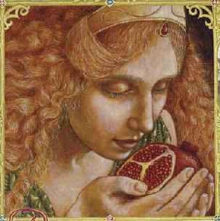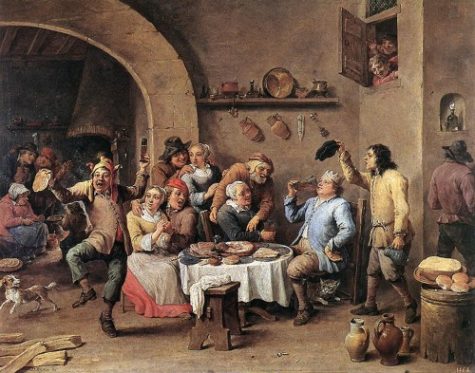Daily Archives: January 5, 2016
 Themes: Luck, Cycles, Youthful Energy
Themes: Luck, Cycles, Youthful Energy
Symbols: Coins, Corn, the number 7, Flower Buds, Pomegranate
About Kore: An aspect of Persephone before her marriage to Hades, this youthful goddess motivates good fortune, zeal, and a closer affinity to earth’s cycles during the coming months.
Kore, whose name means “maiden,” is the youngest aspect of the triple goddess. She was the daughter of Zeus and Demeter, as beautiful as spring’s blossoms and as fragrant as its breezes. It was this beauty that inspired Hades to tempt her with a pomegranate, a symbol of eternal marriage. Because she ate the fruit, Persephone spends winter with Hades as his wife and returns to the earth in spring.
To Do Today (Jan 5 or 6): Traditionally, on this day the Greeks carried an image of Kore around the temple seven times for victory, protection, and good fortune. Since your home is your sacred space, consider walking clockwise around it seven times with any goddess symbol you have (a round stone, vase, or bowl will suffice). As you go, visualize every nook and cranny being filled with the yellow-white light of dawn, neatly chasing away any lingering winter blues.
This day marks winter’s passage and perpetuates Kore’s gusto and luck in your home year-round. Also consider carrying a little unpopped popcorn in your pocket to keep Kore’s zeal and vigor close by for when you need it.
Other Rites of Kore: Epiphanius (fourth century), gives an account of a rite held at Alexandria on the night of January 5-6.
In the temple of Kore – the Maiden (Persephone) – he tells us, worshipers spent the night in singing and flute-playing, and at cockcrow brought up from a subterranean sanctuary a wooden image seated naked on a litter. It had the sign of the cross upon in gold in five places – the forehead, the hands, and the knees. This image was carried seven times round the central hall of the temple with flute-playing, drumming, and hymns. It was said: “To-day, at this hour, hath Kore (the Maiden) borne the Aeon.” The image was then taken back to the underground chamber.
Courtesy of: 365 Goddess and other sources
In Old England, The Twelfth Night marked the end of the winter festival that started on Samhain. The Lord of Misrule symbolizes the world turning upside down with the coming of winter. In the middle ages, the Twelfth Night began on the eve of December 25th moving forward 12 days to January 6th, hence the name the twelve days of Christmas.
The Twelfth Night festival marked the onset of the winter solstice, the point in late December when the sun, whose daily arc had reached its lowest, darkest, coldest point, began its rise toward the longer, warmer days and the coming of spring. On December 25th, the ceremonial Yule log was hauled in to start the hearth fire around which its members and visitors would gather throughout the rest of the Christmas festival days.
Twelfth Night was the final frenzy of feasting, drinking and merry making before the townspeople returned to daily life for the remainder of winter. A grand cake was the focus of the celebratory feast as well as Wassail, Fig Pudding and other generous tasty handmade dishes.
In the ancient times of the Roman Saturnalia, the “king of the feast” was elected by beans, and the Twelfth Night cakes included a bean–or, later, a ring or coin. Whoever was given the slice with the prize became the queen and king for the night and much parading and merriment followed.
In the church calendar, Twelfth Night is the evening before Epiphany (January 6). Because the three wise men (or kings) arrived in Bethlehem bearing gifts for the infant Jesus, Epiphany is also called Three Kings Day and a traditional time of gift giving.
Sources: White Magick Alchemy and Almanac.com




